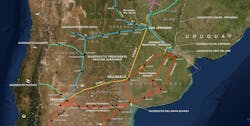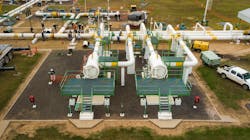Argentina inaugurates President Néstor Kirchner gas pipeline
The Argentine government formally inaugurated the 537-km President Néstor Kirchner Gas Pipeline (GPNK) on July 9. Inauguration of the pipeline is important for the current national government and its presidential candidate, Minister of Economy Sergio Massa, as it aims to reduce reliance on imported fuels for electricity generation.
The 11-million cu m/day (MMcmd) pipeline traverses Neuquén, Río Negro, La Pampa, and Buenos Aires provinces. Its operation will be overseen by Transportadora Gas del Sur (TGS) and will displace gas that would otherwise need to be imported, saving about $2.2 billion in foreign currency outflows in 2023. Future plans for the pipeline include installation of additional compressor units, which could double its capacity to 22 MMcmd.
Public funds paid for the $2.7-billion pipeline. The government is expected before yearend to launch a tender for GPNK’s second section, extending the line to San Jerónimo in Santa Fe province to transport additional Vaca Muerta gas to northern Argentina. Construction cost for the 497-km second section is estimated at $1.9 billion.
On June 22, the Argentine Ministry of Economy approved the contract between Energía Argentina SA (Enarsa), the state-owned company in charge of the project, and Cammesa for transportation of natural gas through GPNK. The contract stipulates that funds collected as transportation payment will be exclusively allocated to reinvestment and financing of GPNK’s expansion.
Northern Gas Pipeline reversal
“YPFB [Yacimientos Petrolíferos Fiscales Bolivianos] has a contract signed with Petrobras for 20 MMcmd. Bolivia's production capacity is 36 MMcmd and its domestic consumption is 14 MMcmd. This leaves 2 million cu m/d available, but efforts have been made to send 4 MMcmd to Argentina in the summer and 8 MMcmd in the winter,” said Álvaro Ríos Roca, managing partner of Gas Energy Latin America and former hydrocarbons minister of Bolivia. “In other words, they have reduced shipments to Brazil to meet Argentina's demands, whose contract will expire in 2024. However, a new contractual addendum will be signed in November to ensure an uninterrupted contract for the volumes of the upcoming year,” said Rios.
Completing NGP will involve reversal of the pipelines that currently extend from the country’s northern region to its center. The reversal involves repurposing existing pipes currently used for imports from Bolivia, pipe that currently flows to central Córdoba province from the San Jerónimo compressor station (the endpoint of NGP’s current second segment). Phase 1 also included adjustments made to connections at Leones and Tío Pujio.
TGN has gas pipeline connections to Chile, Brazil, Bolivia, and Uruguay, which could become destinations for shale gas from Neuquén basin if Vaca Muerta increases production.
Remaining works to complete the reversal involve construction of a 122-km, 36-in. OD gas pipeline between Tío Pujio and La Carlota in Córdoba province. The pipeline will connect the trunk gas transportation systems of TGS and TGN. Additionally, there will be a 62-km loop (30-in. OD) parallel to the current NGP between Tío Pujio and Ferreyra, also in Córdoba.
A loan of $540 million has been secured for NGP from the Andean Development Corp., according to President Alberto Fernández’s administration, and the remaining $172 million will likely be financed by the Argentine state. Funding will allow state-owned Enarsa SA to begin work through the Transport.Ar program, a pipeline development program driven by the national government.
The operational northern trunk gas pipeline, which has been in service since 1960, spans 1,454 km, running in a north-south direction, transporting gas from Campo Durán (Salta) to San Jerónimo (Santa Fe). The 28 MMcmd line is powered by 12 compressor stations and supplies Salta, Jujuy, Tucumán, Santiago del Estero, Catamarca, Córdoba, Santa Fe, and Buenos Aires provinces.
About the Author
Camilo Ciruzzi
South America Correspondent
Ciruzzi is a journalist based in the Argentine province of Río Negro. He has over 30 years of experience in radio and print media. Ciruzzi studied Communication Sciences at the University of Buenos Aires and specialized in energy, political economy, and finance.

